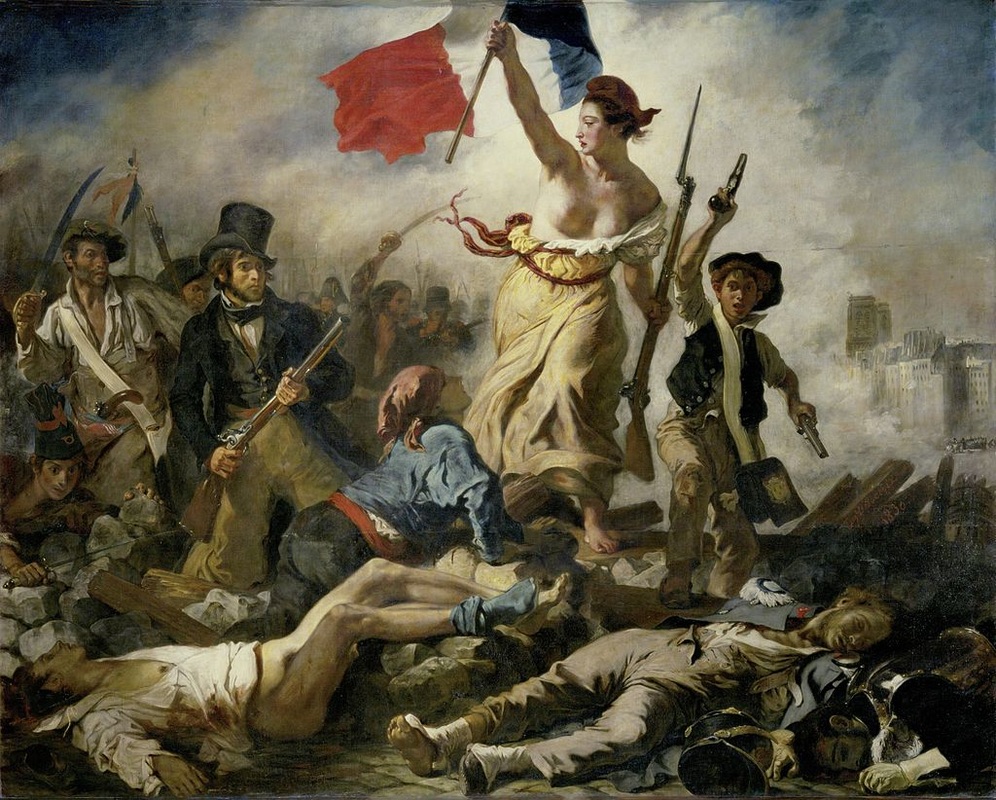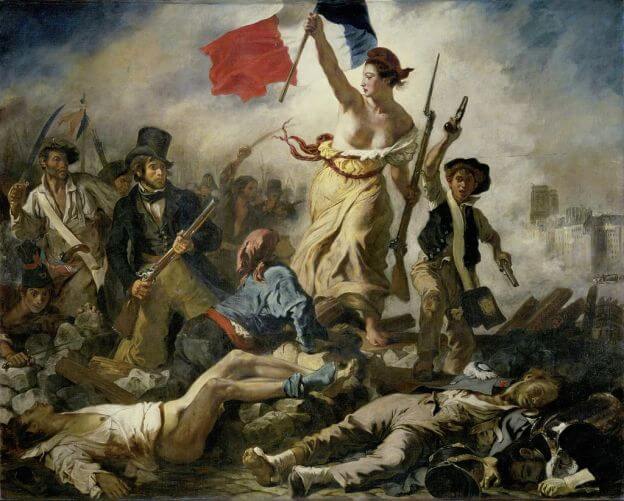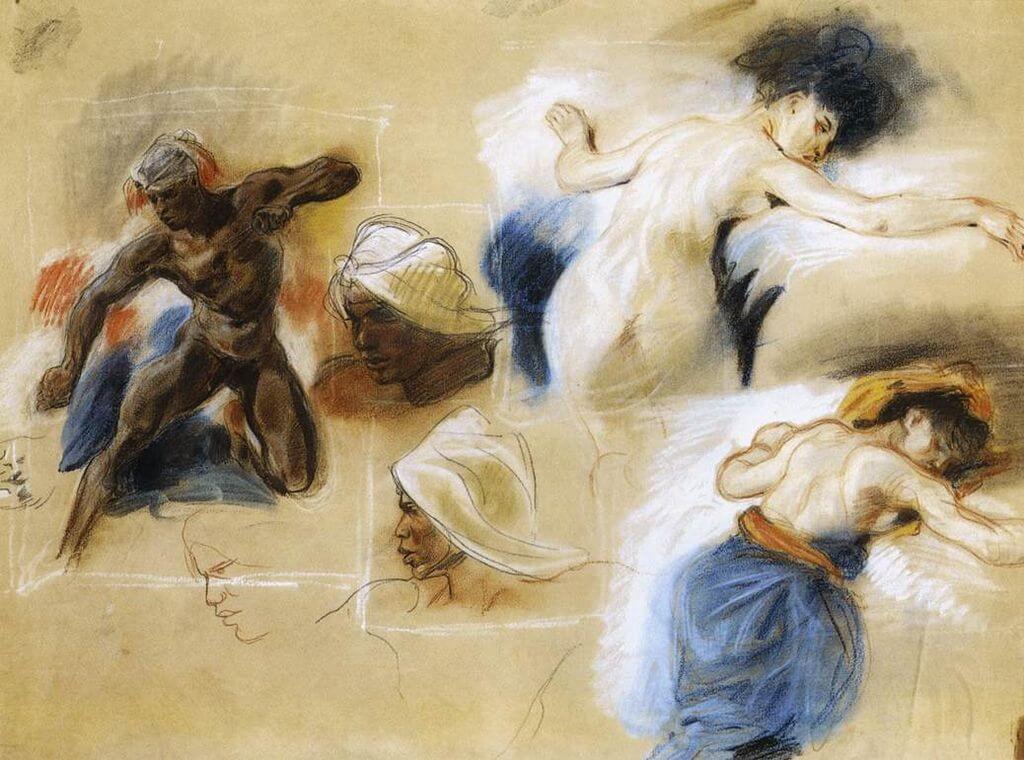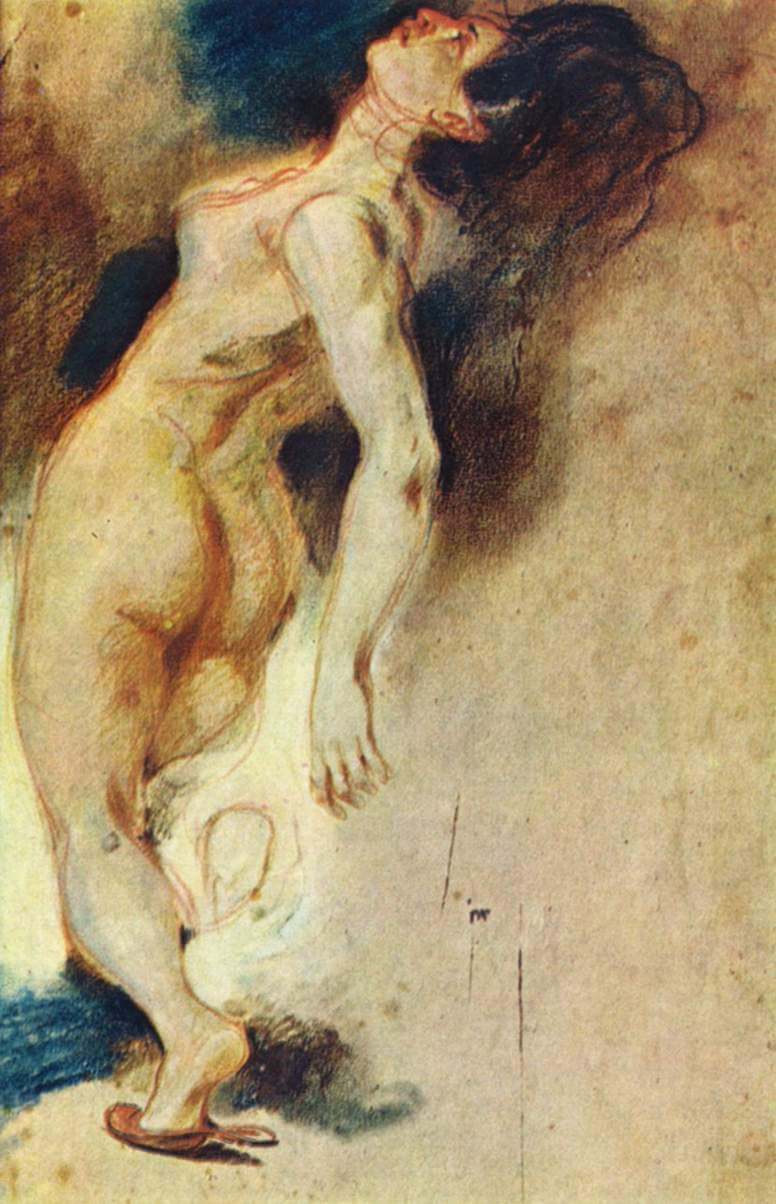|
Where? First floor, room 700 of the Denon wing in the Louvre
When? 1830 What do you see? This painting represents what a revolution feels like for the people involved. The woman in the center, referred to as Liberty, is holding the French tricolor. She stands on top of a barricade, which you can recognize by the pieces of wood and the cobblestones in the foreground. Liberty represents the struggle of the common people for freedom, but at the same time, she shows the energy and excitement that was part of a revolution. In her left hand, she holds an infantry musket. This is a rifle with a bayonet fixed to it, in case she needed to spear an enemy from close range. Liberty is depicted in a victorious pose, and she is showing her breasts to the people. Liberty is surrounded by a mix of people from the French society. On her right is a child brandishing a pair of guns. At her feet is a day laborer from the countryside wearing a blue jacket (notice the red, white, and blue pattern in his clothes, resembling the French flag). The man to Liberty’s left, with the black jacket and the top hat, is represents the middle-class people (some say it is Delacroix himself, but there is serious doubt about this claim). The man in white on the left is a factory worker holding a saber. There is a sharp contrast between the victorious people fighting for the freedom of France and the dead people in the foreground. In the bottom right, you can see a dead soldier and a guardsman. In the background, you can see the smoke of the cannons. In the top right background, the city of Paris is visible with the two iconic towers of the Notre Dame. Finally, the two spars of wood on the right show the signature of the painter, reading “Eug. Delacroix 1830.”
0 Comments
Where? First floor, room 700 of the Denon wing in the Louvre. A smaller version is in the Philadelphia Museum of Art but is currently not on display.
When? The original is from 1827, and the smaller replica is from 1844. What do you see? In the center, King Sardanapalus of Assyria, dressed in white, lays in his bed which is covered with bright red sheets. On the front corners of his bed are two large elephant heads. His bed stands on top of a large pyre. You can see some woodblocks making up the pyre behind the black slave in the left foreground and on the bottom right. While rebellion forces surround his palace, Sardanapalus orders his eunuchs and palace officers to cut the throats of his mistresses. He did not want anyone or anything that gave him pleasure during his life to survive him. He has a calm and disinterested expression which contrast strongly with the cruel scene around him. Notice also that all mistresses and Sardanapalus wear expensive jewelry as the king also wanted his royal possessions to be burned with him on the pyre. On the bottom right is also a collection of crowns and jewelry that are about to go down.
Backstory: Delacroix got his inspiration for the theme of this painting from a play written by the English poet Lord Byron, who in turn was inspired by older texts on the story of Sardanapalus. In 1821, Lord Byron wrote a play called Sardanapalus: A Tragedy (Amazon link to this book) which describes the crazy story of the death of Sardanapalus. In preparation for this painting, Delacroix also consulted some older writings on the death of Sardanapalus. He combined all these sources to create a unique story on the death of Sardanapalus. We can still identify some figures in this painting based on Lord Byron’s play. For example, the man on the left removing a spear from his chest is Salemenes, the brother-in-law of Sardanapalus. He just came back from the battlefield and will die after he removes the spear. And the woman lying on the bed is Myrrha, the lover of Sardanapalus. According to Lord Byron’s story, she was the only one with Sardanapalus on top of the pyre. Who is Sardanapalus? According to the Greek writer Ctesias, Sardanapalus lived in the 7th century BC. He was the last king of Assyria, which was a very large empire in the Middle East between the 25th and 7th century BC. He lived an extremely luxurious life and was very lazy. According to Sardanapalus, the main purpose of life was physical desire. He followed his own advice, dressed in woman’s clothes, wore makeup, and was surrounded by many male and female mistresses. As many people got annoyed by his lifestyle, a group of rebellions formed to defeat Sardanapalus and his troops. Sardanapalus went down in a typical fashion. As some point during the war with the rebellions, he thought that he had defeated the rebellions and started a big party. However, the rebellions came with reinforcements and defeated Sardanapalus, leading to the end of the Assyrian empire. Before he got caught, Sardanapalus burned himself together with many of his eunuchs and mistresses, and most of his royal possessions. Who is Delacroix? Eugène Delacroix (1798-1863) was the leader of the Romantic painters in France. Jean-Auguste-Dominique Ingres was the main artistic rival during his life. Whereas Ingres was the leader of the school of Neoclassical painting, Delacroix believed in the Romantic style and was inspired by artists like Rubens, Tintoretto, and Veronese. The style of Delacroix can be characterized by an emphasis on using colors and depicting emotions, and not on providing a clear composition and shapes of the people in his paintings. In 1830, he painted his most famous work, Liberty Leading the People, which is on display in the Louvre as well. The work of Delacroix has been important for the development of Impressionism later in the 18th century. Artists like Degas, Manet, and Renoir greatly admired the work of Delacroix.
Fun fact: This painting is the largest uncommissioned by Delacroix. He had high hopes of this work and created many sketches that are still available for this painting. Below are two pictures of sketches he made that are in possession of the Louvre.
The painting was first exhibited in the Salon of 1828 in Paris. The painting got many negative reviews. One viewer went so far as threatening to cut off Delacroix's hands such that he could never paint again. There were several reasons for these negative reactions, such as the messy composition and incoherent use of colors. Whereas the French State bought earlier paintings of Delacroix, they did not buy this one. Instead, Delacroix took it back to his studio where it stayed until 1845. He only sold the painting after he made a much smaller replica of the painting owned by the Philadelphia Museum of Art. The larger painting was not on public display until 1921 when the Louvre bought it. Nowadays, this painting is highly appreciated. Looking back, it is one of the early Romantic paintings. Whereas people in the early 19th century were still used to the clarity of the Neoclassical paintings by Ingres and colleagues, the Romantic paintings focused on showing emotions in a more chaotic setting. Interested in a copy for yourself? Poster or canvas. |
Categories
All
|
- Home
- Blog
-
Museums
- Alte Pinakothek
- Art Institute of Chicago
- Baltimore Museum of Art
- Barber Institute of Fine Arts
- Bargello
- Barnes Foundation
- British Museum
- Church of Sant’Anastasia
- Cleveland Museum of Art
- Courtauld Institute of Art
- Detroit Institute of Arts
- Frans Hals Museum
- Galleria Borghese
- Gallerie dell'Accademia
- Getty Museum
- Guggenheim
- Hermitage Museum
- Kunsthistorisches Museum
- Kunstmuseum Basel
- Legion of Honor Museum
- Louvre
- Mauritshuis
- Metropolitan Museum of Art
- Musee d’Orsay
- Museum of Fine Arts in Boston
- Museum of Modern Art
- National Gallery in London
- National Gallery of Art
- National Museum in Poznań
- Norton Simon Museum
- Ny Carlsberg Glyptotek
- Palace of Versailles
- Palazzo Pitti
- Palazzo Vecchio
- Petit Palais
- Philadelphia Museum of Art
- Prado
- Pushkin Museum
- Ravenna Art Museum
- Rijksmuseum
- San Diego Museum of Art
- Santa Maria delle Grazie
- St. Peter's Basilica
- Städel Museum
- Statens Museum for Kunst
- Tate Britain
- Tate Modern
- Timken Museum of Art
- Uffizi
- Vatican Museums
- Wallace Collection
-
Artists
- Altdorfer
- Anguissola
- Berlin Painter
- Bosch
- Botticelli
- Boucher
- Bronzino
- Bruegel the Elder
- Brunelleschi
- Cabanel
- Caillebotte
- Canova
- Caravaggio
- Carpeaux
- Cezanne
- Cimabue
- David
- Degas
- Delacroix
- De Maria
- Donatello
- El Greco
- Fontana
- Fra Angelico
- Fragonard
- Gauguin
- Gentileschi
- Gericault
- Gonzalez-Torres
- Goya
- Hals
- Hogarth
- Hokusai
- Ingres
- Leonardo da Vinci
- Lippi, Filippo
- Longhi, Barbara
- Lorrain
- Makovsky
- Manet
- Massys
- Matisse
- Merian
- Michelangelo
- Mochi
- Modigliani
- Monet
- Panini
- Parmigianino
- Perugino
- Picasso
- Pisanello
- Raphael
- Rembrandt
- Renoir
- Reynolds
- Rivera
- Rodin
- Rubens
- Scultori
- Seurat
- Steen
- Tintoretto
- Titian
- Toulouse-Lautrec
- Turner
- Uccello
- Van der Weyden
- Van Dyck
- Van Eyck
- Van Gogh
- Van Hemessen
- Vasari
- Velazquez
- Vermeer
- Veronese
- Vigée Le Brun
-
Locations
- Books
- About Us





